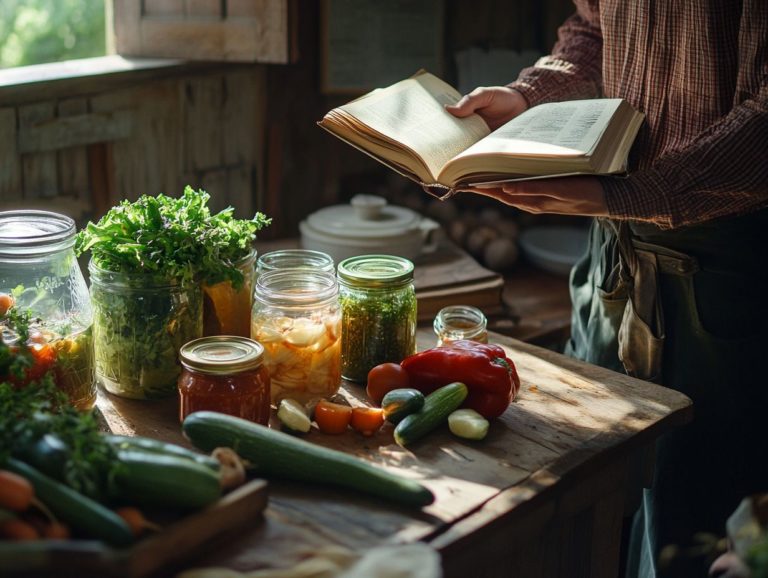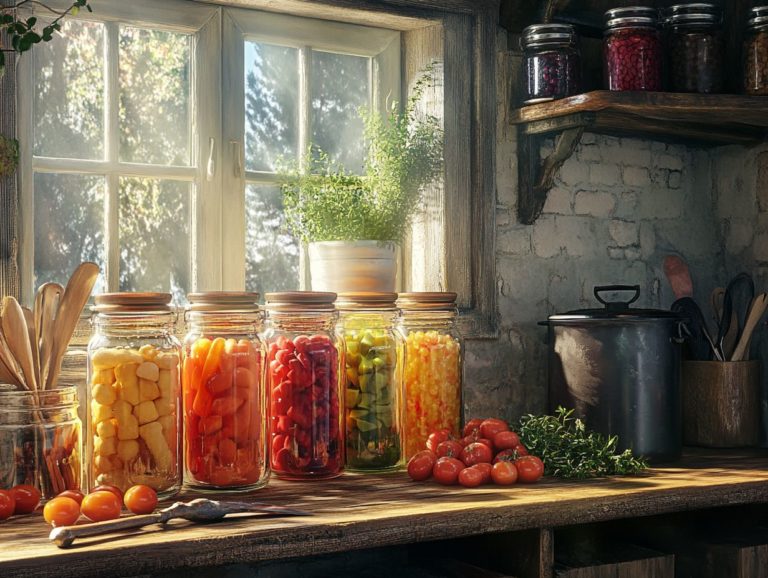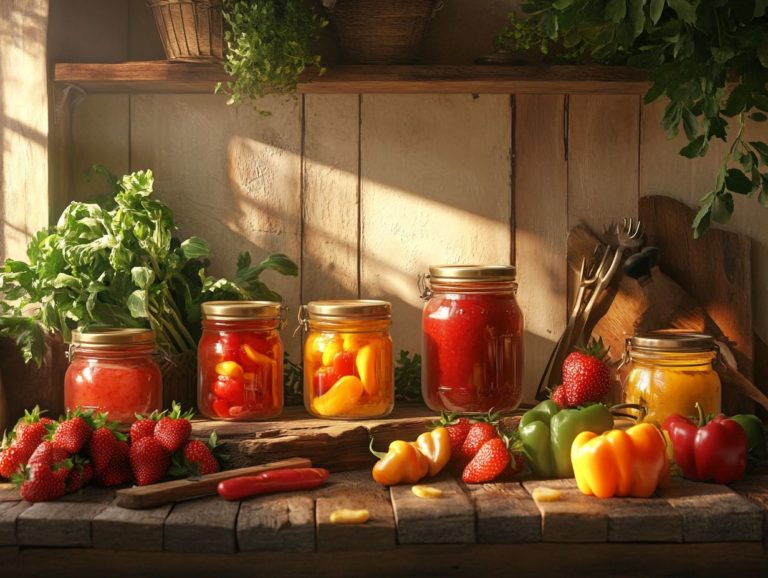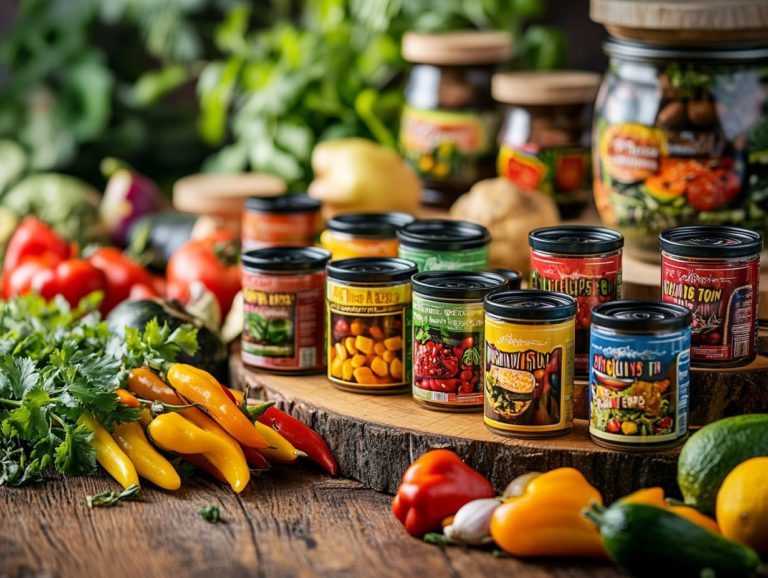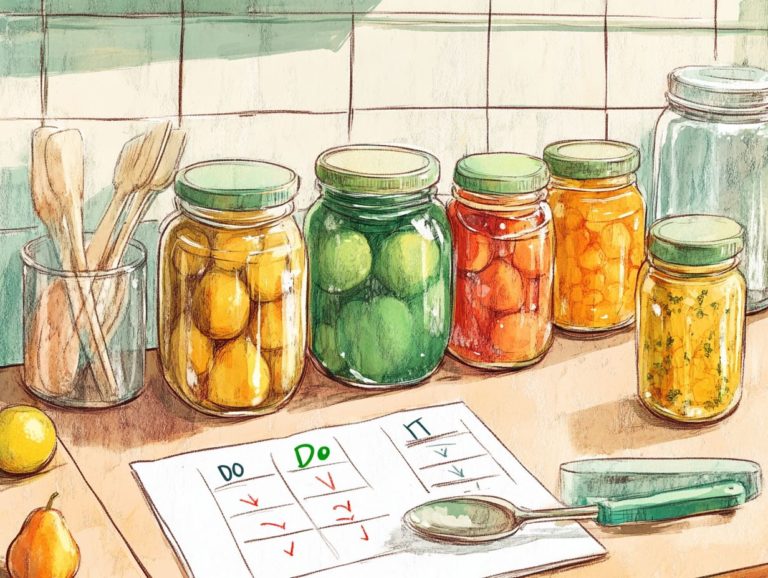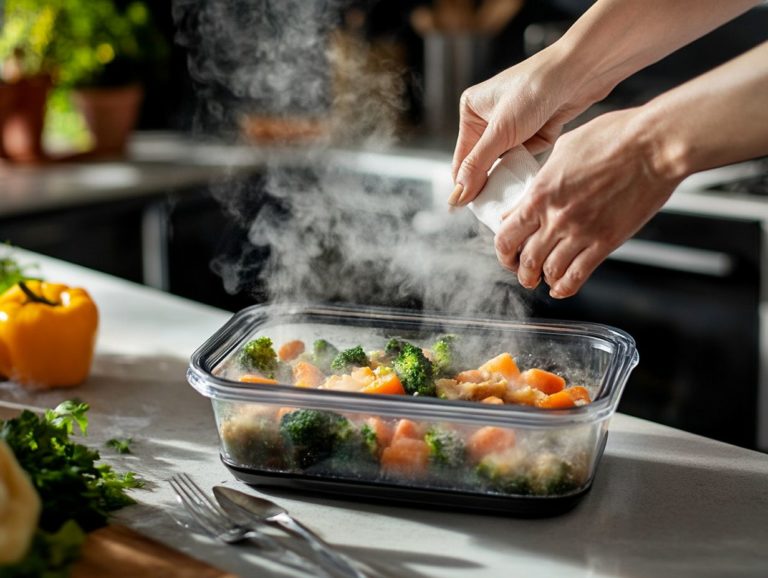Canning Techniques for Preserving Juice
Canning juice is an exciting way to enjoy your favorite flavors throughout the year. You can savor fresh-tasting juice by using methods like boiling water canning or pressure canning.
This article highlights the many benefits of canning. You will learn about extending shelf life, essential tools, and the role of sweeteners like sugar and Splenda in enhancing flavor.
Discover a step-by-step guide on preparing, sealing, and storing your juice. We will also explore alternative preservation methods like freezing and dehydrating.
Prepare to elevate your juice-making experience! Focus on fresh fruits like blackberries, blueberries, elderberries, and strawberries.
Contents
Key Takeaways:
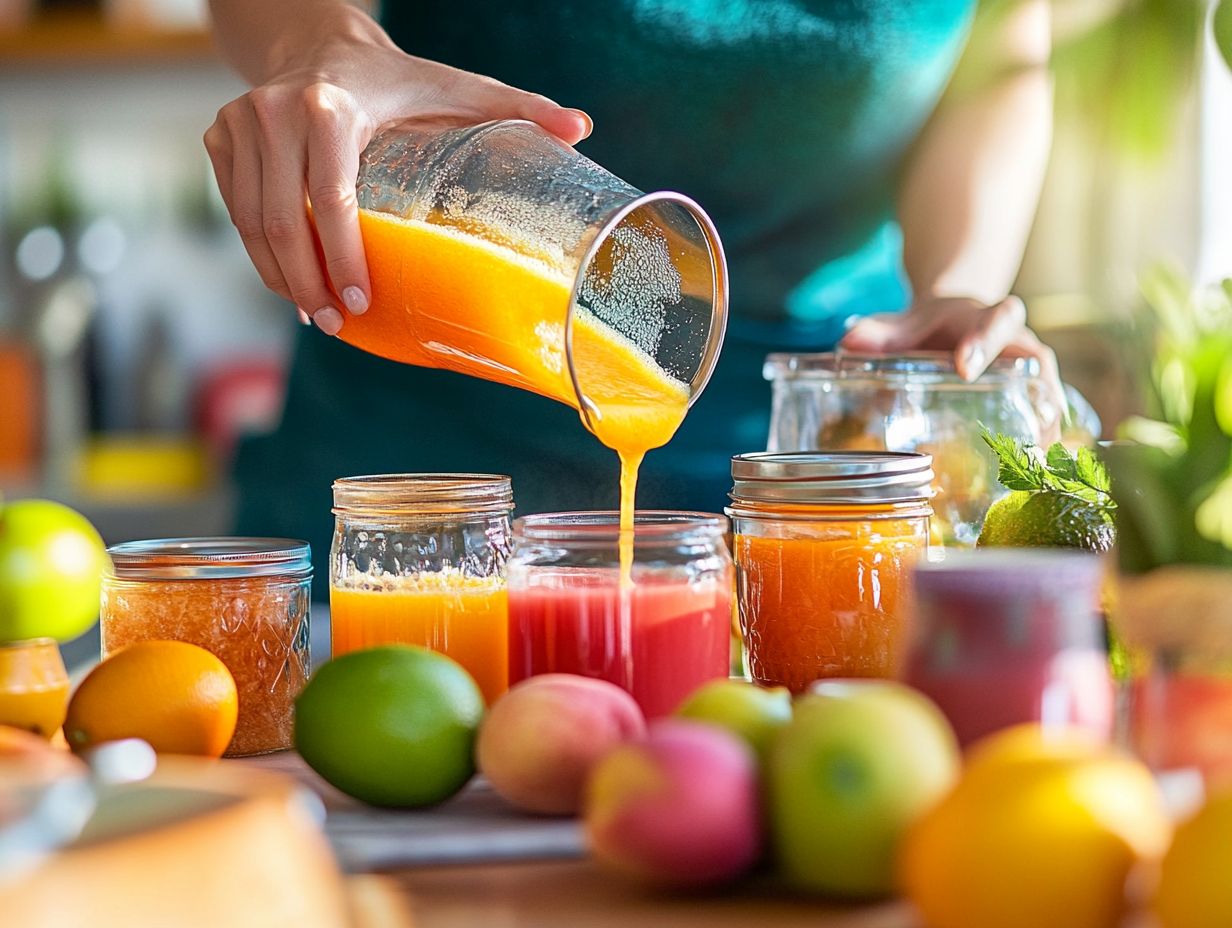
- Canning juice extends its shelf life and provides a convenient way to enjoy fresh juice year-round with jars and lids designed for canning.
- Essential tools include a canner, jars, lids, and a steam juicer, which helps keep fruit quality while extracting juice.
- Proper sterilization and storage techniques are key to ensuring the safety of canned juice and preventing spoilage.
What is Canning?
Canning is an age-old method of preserving food by sealing it in jars. This keeps food fresh and extends its shelf life, especially for fruits and juices.
This technique is popular for fruits preserved using methods like boiling water canning or pressure canning. By creating a vacuum seal, you limit oxygen exposure, which slows down harmful bacteria growth.
It s crucial to follow guidelines from reliable sources like the Ohio State University Extension. These measures help prevent dangerous bacteria, such as Clostridium botulinum, which can cause serious illness.
Canning has evolved over time, allowing for a wider variety of food preservation. Fruits like peaches, pears, and berries are commonly canned for their natural sugars and acidity, which help preserve them well.
Mastering sealing techniques is vital. A secure seal not only keeps flavors intact but also prevents contamination.
Understanding safe canning methods, including sterilization and adding citric acid or ascorbic acid, is essential for anyone looking to delve into this rewarding culinary project.
Benefits of Canning Juice
Canning juice has amazing benefits! It extends shelf life and offers incredible convenience, especially when using top canning techniques for produce and proper preservation methods.
When you can juice from fruits like blackberries, blueberries, and strawberries, you keep their nutrients and flavors intact. This makes it a great choice for those who enjoy homemade beverages without added preservatives or excess sugar.
Canning also lets you use natural sweeteners such as sugar, lemon juice, or fruit juice to boost flavor while maintaining a healthy approach.
Prolonged Shelf Life and Convenience
The primary advantage of canning lies in its remarkable ability to extend the shelf life of fruits and homemade juices, offering essential convenience for your busy household while preserving food for later use. By employing proper canning techniques, such as vacuum sealing and utilizing sugar syrup, you can store seasonal fruits like raspberries and currants without the anxiety of spoilage. This allows you to savor these flavors long after the harvest.
This preservation method effectively locks in vital nutrients and rich flavors, making it an appealing choice for those who prioritize a nutritious diet free from artificial additives. Canned fruits and vegetables, along with juices made from fresh fruits, not only delight the palate but also retain their vitamins. This presents a cost-effective way to incorporate fresh produce into your everyday meals.
For those navigating tight schedules, the convenience of canned goods and kitchen tools like a steam juicer simplifies meal preparation. Essential tools like pressure canners, jars, and lids are crucial for successful canning, enabling you to create versatile ingredients that can easily elevate soups, salads, or desserts with minimal effort.
Equipment and Supplies Needed
To embark on your canning journey successfully, you ll want to gather the right equipment and supplies, including high-quality canning jars and lids for optimal results. This includes high-quality jars, lids, and a dependable pressure canner or boiling water canner to ensure the safety of your canned goods.
Choosing the right equipment is essential; it not only influences your preservation method but also guarantees food safety throughout the canning process, particularly regarding the prevention of contamination. Selecting appropriate jars tailored for either liquid or solid contents and employing reliable sealing methods can significantly enhance the success of your canning endeavors.
Essential Tools for Canning Juice
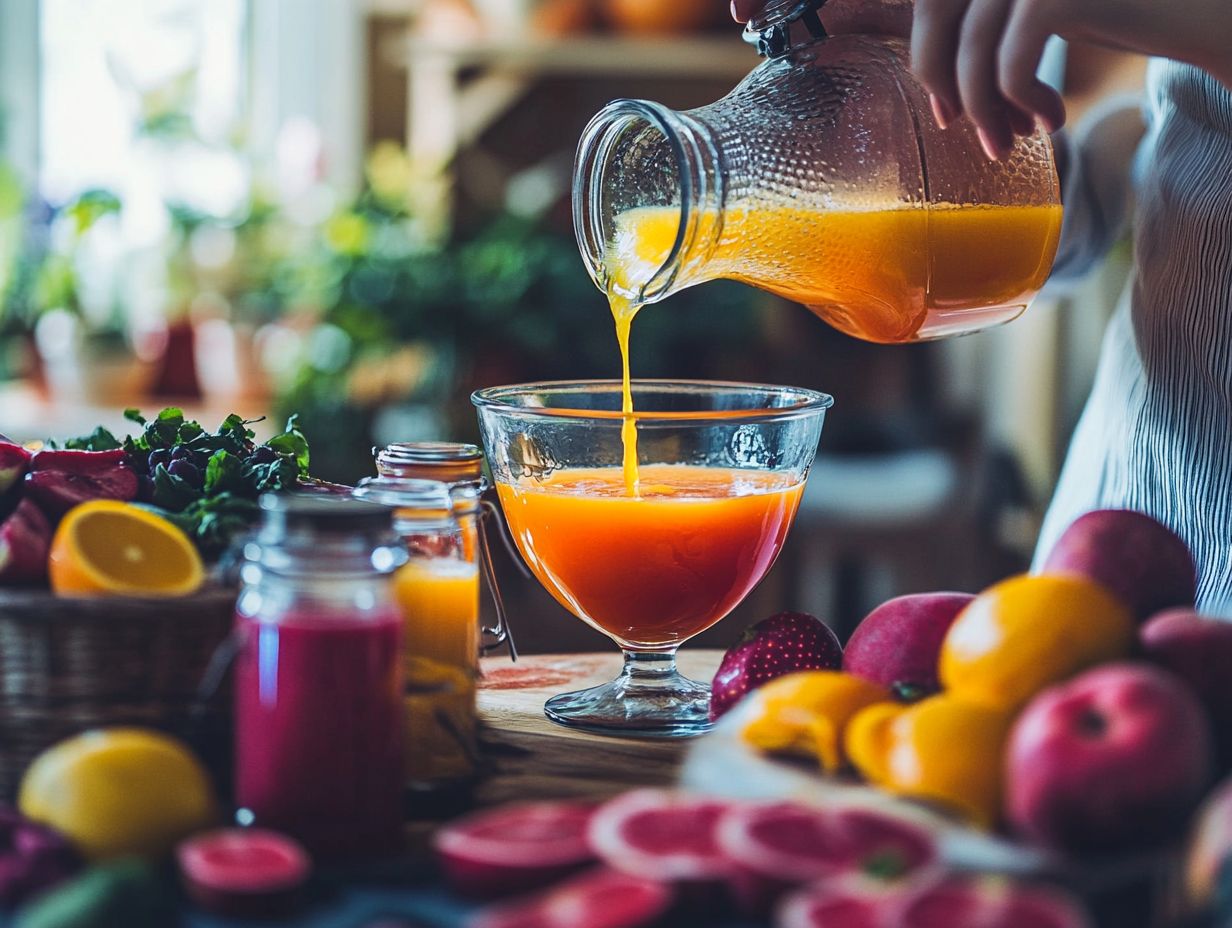
Essential tools for canning juice include specialized equipment such as jars, lids, and sealing jars, all crucial for ensuring successful preservation. A steam juicer is particularly invaluable, allowing you to extract juice from fresh fruits while maintaining the fruit’s quality. Additionally, exploring canning techniques for unique flavor profiles can enhance your creations. Use proper sealing methods, like vacuum packaging, to prevent spoilage and keep freshness longer.
To achieve optimal results, select jars made from thick glass that can withstand high temperatures, ensuring the safety of your canned goods. Opt for lids specifically designed for canning, as they create the airtight seal necessary to keep contaminants at bay and prevent botulism, a harmful bacteria that can cause serious illness. Using a water bath canner for home canning is advisable; it helps process jars properly while ensuring even heat distribution and effective sterilization.
Best practices dictate that you sterilize the jars and lids beforehand to eliminate any lingering bacteria. By employing reliable sealing methods and checking the integrity of the seal after processing, you significantly reduce the risk of spoilage, keeping your juices vibrant and flavorful for future enjoyment, especially when using a pressure canner.
Step-by-Step Canning Process
Start your canning journey now! The step-by-step canning process requires careful preparation of both juice and jars, ensuring that every component works seamlessly together for effective food preservation and the safety of your final product.
You have the option to select the hot pack method, where the juice is heated prior to filling the jars, or the raw pack method, which involves adding raw fruit directly for optimal flavor retention. Grasping the nuances of each approach, including the use of citric acid to enhance preservation, is essential for attaining the best possible results.
Preparing the Juice and Jars
Preparing the juice and jars is a critical step in the canning process. This sets the stage for successfully preserving fruit quality and flavor while preventing contamination. Begin by selecting ripe, fresh fruits like strawberries or elderberries. Decide whether the hot pack method for heating the juice or the raw pack method for direct filling suits your needs better, especially when canning berries.
To achieve optimal results, examine each fruit for firmness and any signs of over-ripeness. Using overly ripe fruit can compromise the final product. Once you ve made your selection, wash the fruits thoroughly to eliminate any residue before proceeding with the canning process.
When preparing the jars, sterilization is non-negotiable, especially when canning fruits that are prone to contamination. You can accomplish this by submerging the jars in boiling water for at least ten minutes, ensuring any bacteria are effectively eliminated.
Be sure to fill the jars correctly and leave the right amount of headspace the space left at the top of the jar to prevent overflow or spoilage.
Wiping the rims of the jars with a clean cloth is essential for ensuring a proper seal and maintaining that freshly squeezed taste over time. This small detail plays a significant role in your canning success.
Sealing and Storing the Jars
Sealing and storing jars correctly is crucial for ensuring that your canned juice remains safe and free from spoilage. Use high-quality lids and ensure a vacuum seal to preserve not just the flavor but also the nutritional quality of your juice for an extended period.
Check that the seals have formed properly; press the center of the lid if it springs back, the seal isn t airtight, which can lead to oxidation. To extend the shelf life of your jars, always store them in a cool, dark place away from light and heat, which can degrade the quality of your canned goods. This practice is vital to keep your juice tasting its absolute best!
Familiarizing yourself with common spoilage signs, such as off odors, bubbles, or mold, will alert you to any issues before they escalate. This ensures your preservation efforts yield delicious and safe results for everyone involved. Don’t overlook vacuum packaging techniques; they effectively remove excess air from jars before sealing to prevent oxidation and spoilage.
Safety Precautions for Canning Juice
Safety precautions for canning juice are essential to prevent contamination and safeguard the integrity of your final product from spoilage. To achieve this, it’s important to follow canning techniques for small batches and employ proper sterilization techniques to eliminate harmful microorganisms like Clostridium botulinum to prevent botulism.
If these threats are left unchecked during the canning process, they can lead to botulism, a serious health risk that safe canning practices can prevent. By prioritizing these measures, you ensure not only the quality of your juice but also the safety of those who enjoy it, adhering to guidelines from the United States Department of Agriculture.
Proper Sterilization and Storage Techniques
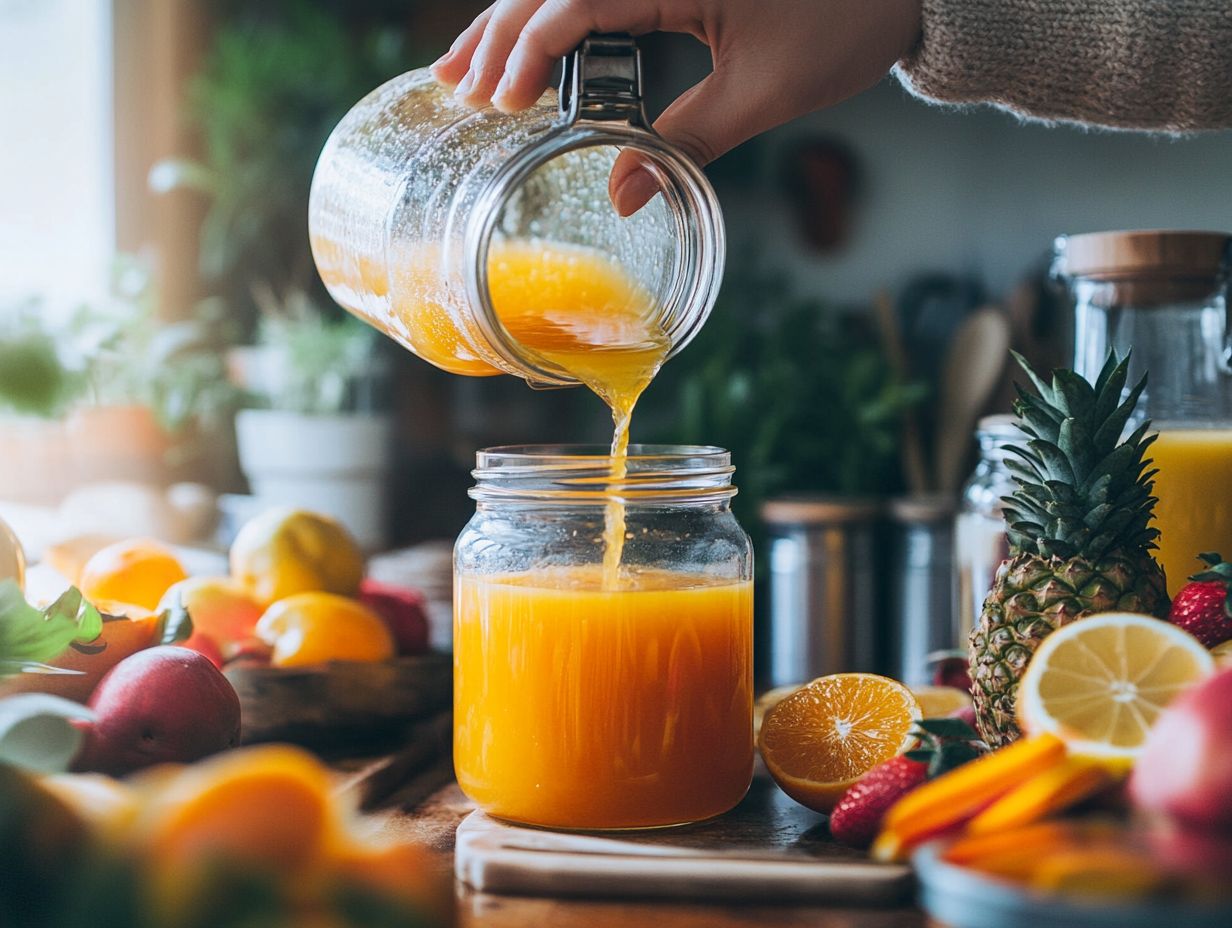
Proper sterilization and storage techniques are essential elements of the canning process. They ensure that your final product remains safe for consumption and free from contaminants. By thoroughly sterilizing your jars and equipment, you significantly reduce the risk of contamination, which is crucial for preventing spoilage and preserving the quality of your juice.
Employing methods such as boiling jars for a specified duration or using a dedicated sterilization solution greatly enhances safety. Remember to allow your jars to cool completely before filling them. Once sealed, store them in a cool, dark place to maximize their shelf life.
After the canning process, routinely check for signs of spoilage, like bulging lids or unusual odors. These can be critical indicators of problems. By adhering to best practices for storage keeping your canned products at a consistent temperature and out of direct sunlight you can ensure that your canned goods stay fresh and delightful for months!
Alternative Methods for Preserving Juice
Along with canning, you have several alternative methods for preserving juice that suit various preferences and needs. Techniques like freezing and dehydrating effectively retain the flavor and nutritional value of the juice while offering added convenience. For those interested in canning, exploring canning techniques for using up surplus produce can be especially beneficial.
Freezing and Dehydrating Options
Freezing and dehydrating are excellent methods for preserving juice, providing both easy storage and enhanced convenience in meal preparation. Using freezer-safe containers for freezing or dehydrators machines that remove moisture from food for creating fruit powders allows you to maintain the juice’s nutritional integrity and flavor.
When freezing juice, remember not to fill containers to the brim. This allows for expansion as the juice freezes, preventing any unpleasant spillage. Opting for smaller portions facilitates quick thawing and minimizes waste.
For dehydration, aim for low temperatures and good airflow. Countertop dehydrators are an ideal choice. Pre-treating fruit with lemon juice elevates the flavor and helps preserve its vibrant color.
The secret to success lies in using fresh, high-quality ingredients. This ensures your juice retains its vibrant flavor and essential nutrients, delivering the best results every time! Try these techniques today and savor the incredible flavors of your homemade juice!
Frequently Asked Questions
What are the benefits of canning?
Canning lets you enjoy fresh juice all year, locking in nutrients and flavors what’s not to love?
What equipment do I need for canning?
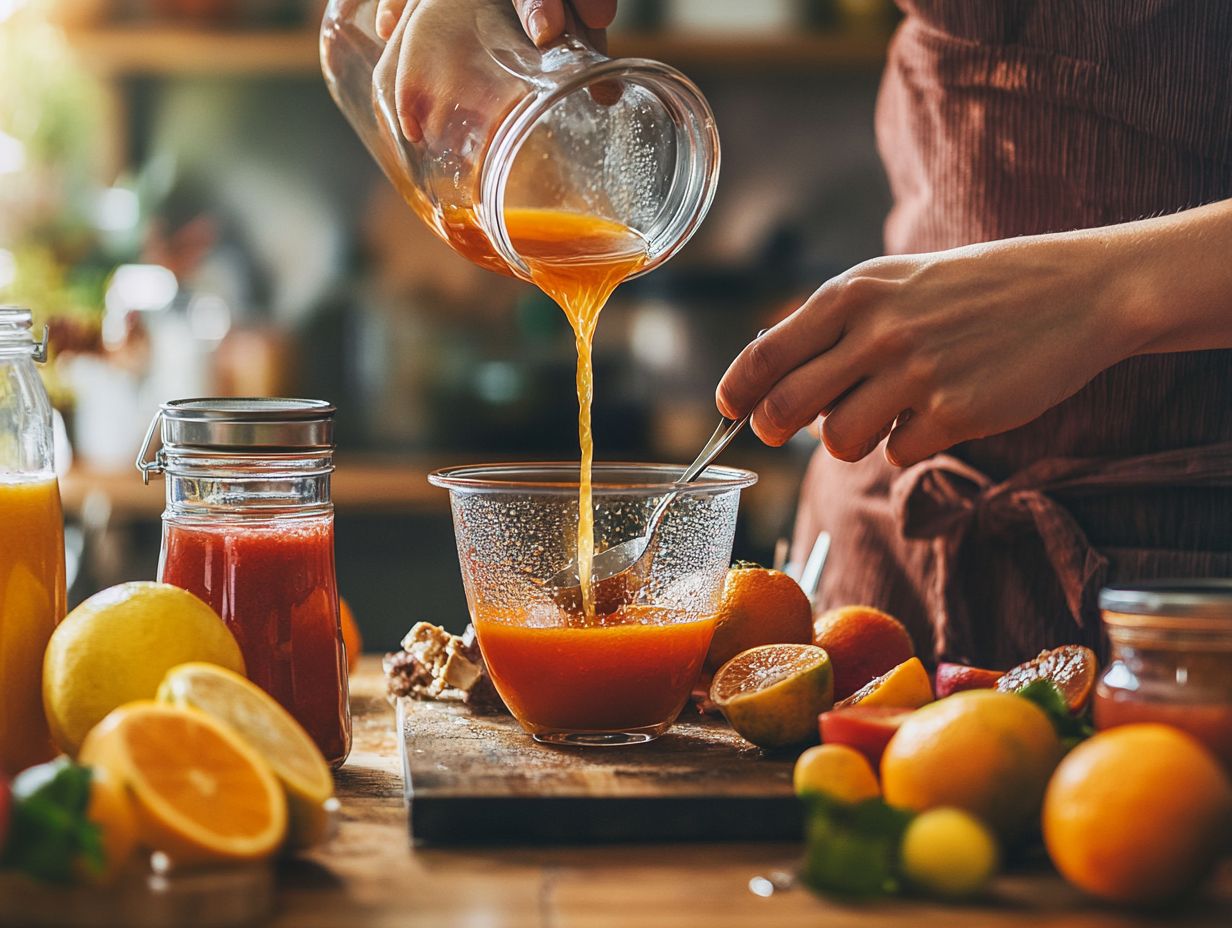
You will need a canning pot, jars, lids, a jar lifter, and a canning funnel.
Can any type of juice be preserved using canning?
Yes! You can use canning techniques to preserve any type of juice, including fruit juices, vegetable juices, and even homemade juices.
How do I properly sterilize my jars for canning?
To sterilize your jars, wash them in hot soapy water, rinse, and place them in boiling water for 10 minutes. Let them air dry before use.
What is the recommended storage time for canned juice?
Canned juice can typically be stored for up to one year in a cool, dry place. However, it is best to consume within 6-8 months for optimal flavor and quality.
Can I reuse jars and lids for canning?
Jars and lids can be reused for canning as long as they are in good condition and do not have any dents, cracks, or rust. Lids should not be reused more than once for canning to ensure a proper seal.

